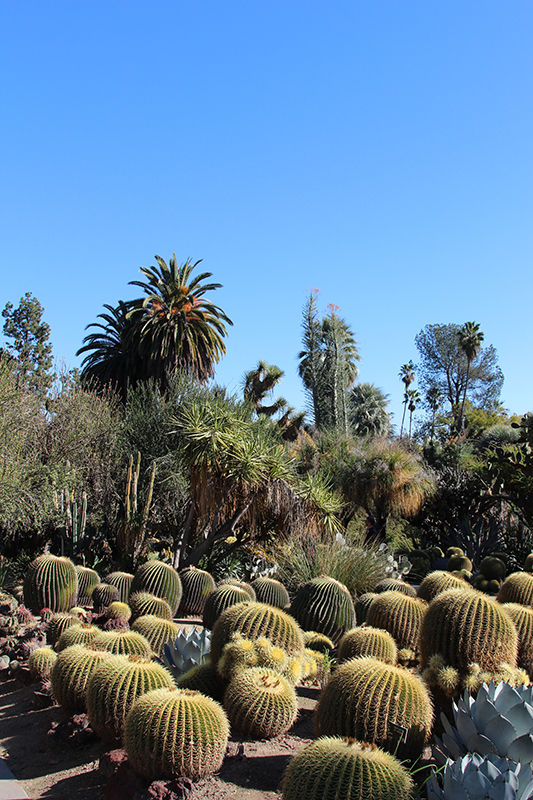The Huntington Gardens and Library in Pasadena boasts what is widely considered one of the world’s premier collections of desert plants. The famed Brazilian landscape architect Roberto Burle Marx called it “the most extraordinary garden in the world,” period.
You can learn more, among other places, in the book “Desert Plants: A Curator’s Introduction to the Huntington Desert Garden” by Gary Lyons.
“As you might imagine,” director Jim Folsom observes in the foreword, “when a garden includes 12 acres of plants, rockery and paths, has several thousand species to boast, and entails the life’s work of many people, there are wonderful specimens to encounter, great stories to tell and myriad lessons to learn.
“You do not merely visit the Desert Garden: you enter it, you are surrounded by and immersed in this wholly different and, at first sight, perhaps strange dreamscape. This garden takes you in and speaks to you in a fresh and compelling voice. Shape, form, movement, color and texture have different meaning here. Plant life and presentation defy, and then reconstruct, your sense of what might be possible.”
The history is fascinating. The colorful characters such as railroad magnate Henry E. Huntington himself, William Hertrich, the early ranch superintendent and foreman who originally sold Huntington on the idea of a desert garden, and T. Harper Goodspeed, California botanist and author of “Plant Hunters in the Andes.”
The plant expeditions, discoveries and (reading-between-the-lines) plunders.
The mysteries (where did those hundreds of tons of a volcanic rock called scoria that were delivered circa 1931 come from? To this day no one knows); the 15-to-20 year hiatus during the Depression and WWII; the 1949 freeze when much of the garden was under snow; and the meticulous and ever-evolving collecting, planting, replanting, propagation and design.
But to me the best way to experience the garden is as a lover of beauty.
To come as a layperson is to enter an alternate world of weirdly-shaped shade trees; of plants from Mexico, Australia, South America and Africa; of agaves, succulents, bromeliads, yuccas, puyas and cacti; and stands of aloe blooming flame-red, buttercup-yellow and a rich, deep gold.
Plants grow in clusters, snarls, cozy families (don’t miss the spectacular barrel cacti), crammed masses and solitary splendor. Plants cascade, meander and explode, and seemingly sleep. Plants, I know from my background reading, have been trained, coaxed, watered, pruned, fed, moved to a shadier or higher or wetter or dryer spot, hovered over, nursed back to health, treasured and mourned.
A Black Aeonium (“Zwartkop”), wine-dark red with lime green undertones, is juxtaposed with a mat of silvery blue-gray ice plant. A crown- of-thorns (euphorbia milii), its deep rose-colored bracts enclosing tiny yellow flowers, holds regal court behind a cluster of dark volcanic rock.
Aloe leaves can be notched, serrated, pimpled, blotched, spotted or viciously thorned; smoothed, rounded, spear-like, or arranged in tiers; and edged with rose-red, olive green or jet black.
Succulents range in color from the palest celadon to sea-green, acid green, a rich emerald green and rust. Cacti have paddles, arms, ribs that undulate like waves in the sea, hairdos.
A notocactus warasii from Brazil sports what looks like a jaunty butter-yellow toupee. A bed of mammillaria geminispina, small white puffballs you’d bet your life would never in this world bloom, are miraculously adorned with tiny haloes of brilliant magenta.
A monarch butterfly frolics on a gone-to-seed kalanchoe. Three mourning doves root beneath an alluaudia procera, a clump of 15-foot tall grayish spears covered, ocotillo-style, with small rich green leaves.
Blossoms take the form of dangling coral-colored bells, flirty pink sparklers, candy-corn firecrackers. Across the downward-sloping paths waft indescribably sweet fragrances, exotic, siren smells from a lost world we’ve reached for, but never quite touched, our whole lives.
There’s more than I can do in one day: the Desert Garden Conservatory, the Heritage Walk, the annual May plant sale.
I come upon what looks to be a beautifully-dressed mother and daughter, sitting stunned on a bench. “Fantastic, isn’t it?” I exclaim. The mother shades her eyes against the sun and grins, “It’s hard to take it all in.”
A yellow finch perches on what it clearly recognizes as a third cousin: a fringed bloom of honey-colored aloe. Yellow, said van Gogh, is the color of the Resurrection.
But passing a stand of creeping devil cactus (stenocereus eruca), I begin to imagine the Desert Garden as night comes on, and the birds fall silent, and the plants so gloriously in bloom by day morph into menacing silhouettes of spiny cacti and twisted tree limbs. I imagine Christ praying in the Garden at Gethsemane, sweating tears of blood:
“Father, let this cup pass from me, but Thy will, not mine, be done.”
Something new comes to me, a layer of significance to the Passion story I’d never quite grasped:
Even as Christ prepared to die, the Father thought to place him in a garden. Even as he went to his crucifixion, the ground where he knelt in anguish foreshadowed new life.
Heather King is a blogger, speaker and the author of several books.
Interested in more? Subscribe to Angelus News to get daily articles sent to your inbox.

